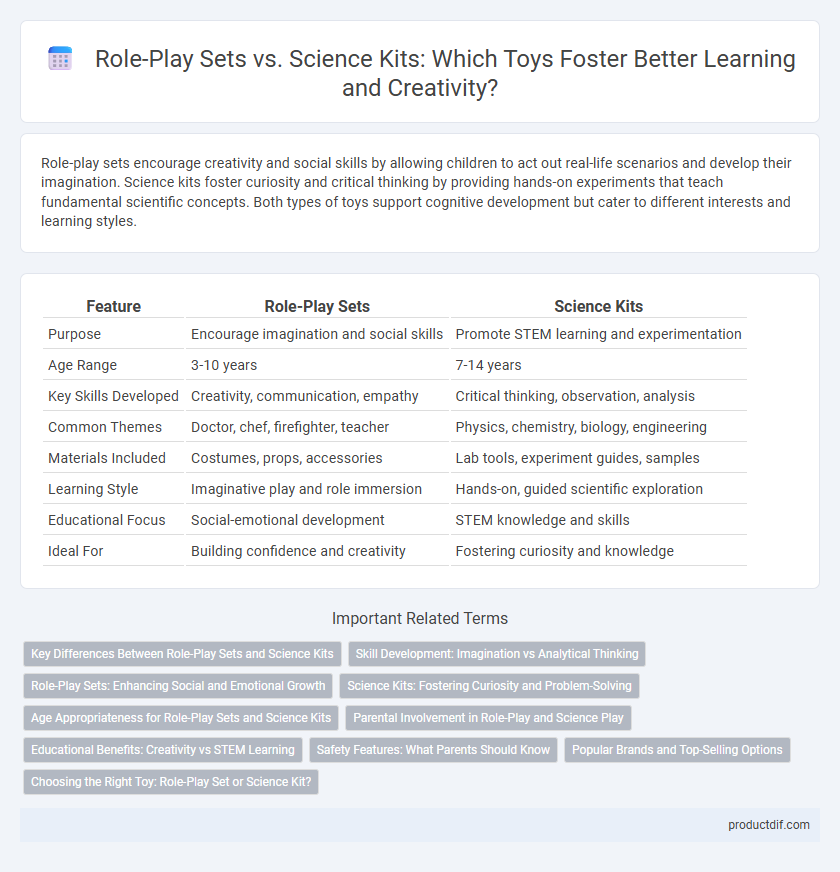Role-play sets encourage creativity and social skills by allowing children to act out real-life scenarios and develop their imagination. Science kits foster curiosity and critical thinking by providing hands-on experiments that teach fundamental scientific concepts. Both types of toys support cognitive development but cater to different interests and learning styles.
Table of Comparison
| Feature | Role-Play Sets | Science Kits |
|---|---|---|
| Purpose | Encourage imagination and social skills | Promote STEM learning and experimentation |
| Age Range | 3-10 years | 7-14 years |
| Key Skills Developed | Creativity, communication, empathy | Critical thinking, observation, analysis |
| Common Themes | Doctor, chef, firefighter, teacher | Physics, chemistry, biology, engineering |
| Materials Included | Costumes, props, accessories | Lab tools, experiment guides, samples |
| Learning Style | Imaginative play and role immersion | Hands-on, guided scientific exploration |
| Educational Focus | Social-emotional development | STEM knowledge and skills |
| Ideal For | Building confidence and creativity | Fostering curiosity and knowledge |
Key Differences Between Role-Play Sets and Science Kits
Role-play sets encourage imaginative play by allowing children to mimic real-life scenarios, enhancing social skills and creativity through character-driven activities. Science kits focus on hands-on experiments that promote scientific thinking, problem-solving abilities, and understanding of scientific concepts like chemistry, physics, and biology. While role-play sets stimulate emotional and social development, science kits primarily advance cognitive skills and knowledge retention in STEM fields.
Skill Development: Imagination vs Analytical Thinking
Role-play sets enhance creativity and social skills by encouraging children to immerse themselves in imaginative scenarios, fostering empathy and storytelling abilities. Science kits promote analytical thinking through hands-on experiments that develop problem-solving, observation, and critical reasoning skills. Both toy types support cognitive growth but target distinct aspects of child development.
Role-Play Sets: Enhancing Social and Emotional Growth
Role-play sets foster social and emotional development by encouraging children to engage in imaginative scenarios that enhance empathy, communication, and collaboration skills. These toys simulate real-life situations, allowing kids to practice problem-solving and emotional regulation within a safe environment. Research shows that interactive role-play can significantly boost a child's confidence and understanding of social dynamics.
Science Kits: Fostering Curiosity and Problem-Solving
Science kits stimulate curiosity and enhance problem-solving skills by providing hands-on experiments that mirror real scientific processes. These kits often include tools and materials for conducting chemistry, physics, or biology activities, encouraging exploration and critical thinking. Engaging with science kits fosters a deeper understanding of scientific concepts, making them a valuable educational resource for children.
Age Appropriateness for Role-Play Sets and Science Kits
Role-play sets typically suit children aged 3 to 8, fostering creativity and social skills through imaginative scenarios, while science kits target ages 6 to 12, encouraging hands-on learning in subjects like chemistry and physics. Selecting age-appropriate toys ensures cognitive and motor skills development aligned with each child's growth stage. Parents should consider complexity levels and safety features to match the child's maturity and interests effectively.
Parental Involvement in Role-Play and Science Play
Role-play sets encourage parental involvement by fostering cooperative storytelling and social skills development, allowing parents to actively participate in imaginative scenarios. Science kits promote hands-on learning through experiments, often requiring parental guidance to explain scientific concepts and ensure safety. Both types of toys enhance cognitive growth, but parental interaction in role-play sets tends to focus more on communication and creativity, while science kits emphasize critical thinking and problem-solving.
Educational Benefits: Creativity vs STEM Learning
Role-play sets foster creativity by encouraging imaginative scenarios and social skills, enhancing language development and emotional intelligence. Science kits provide hands-on STEM learning opportunities, promoting critical thinking, problem-solving, and knowledge of scientific concepts. Both types of toys play a vital role in holistic child development by targeting different educational benefits.
Safety Features: What Parents Should Know
Role-play sets often include costumes and accessories designed with non-toxic materials and rounded edges, minimizing choking hazards for young children. Science kits typically contain small parts and chemicals, requiring parents to verify age recommendations and look for kits labeled "non-toxic" or "safe for children." Ensuring safety certifications such as ASTM or CPSIA approval is crucial when selecting either toy type to protect children during play.
Popular Brands and Top-Selling Options
Role-play sets from popular brands like Melissa & Doug and KidKraft offer immersive imaginative play experiences, emphasizing social skills and creativity. Science kits such as those by National Geographic and Thames & Kosmos focus on hands-on experiments that foster STEM learning and critical thinking. Top-selling options often highlight durability and educational value, with role-play sets encouraging storytelling and science kits promoting exploration of biology, chemistry, and physics concepts.
Choosing the Right Toy: Role-Play Set or Science Kit?
Selecting the right toy depends on your child's interests and developmental goals; role-play sets enhance creativity and social skills through imaginative scenarios, while science kits promote critical thinking and STEM learning by engaging kids in hands-on experiments. Role-play sets often include costumes and tools for professions like doctor or chef, fostering empathy and communication, whereas science kits cover topics such as chemistry, physics, or biology, encouraging inquiry and problem-solving. Evaluating your child's preferences for interactive storytelling versus scientific exploration helps determine whether a role-play set or science kit will provide more educational value and sustained engagement.
Role-play sets vs science kits Infographic

 productdif.com
productdif.com